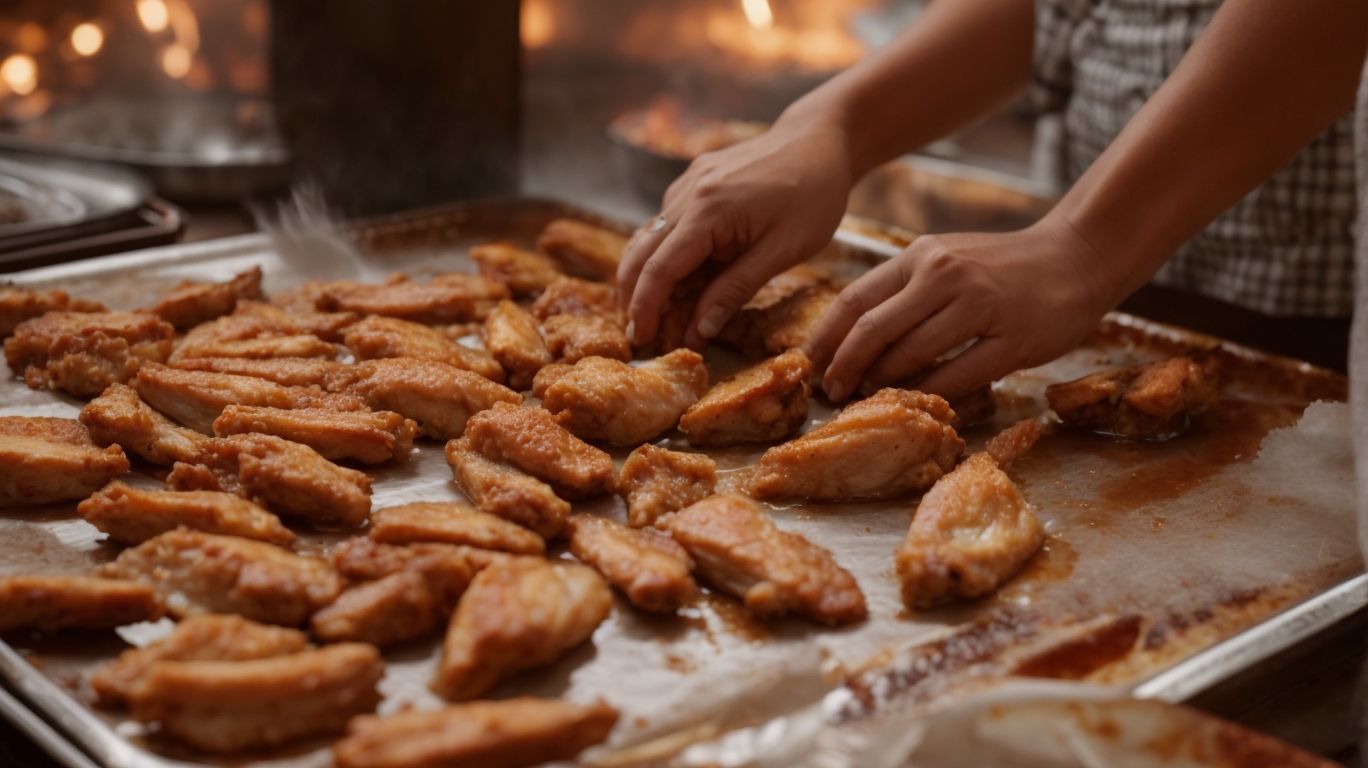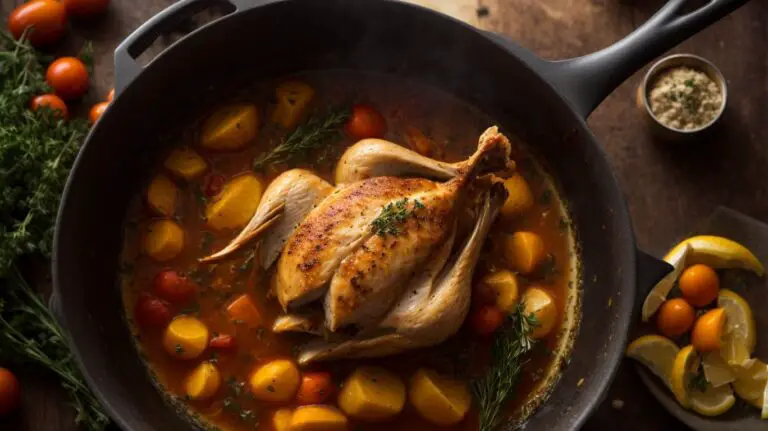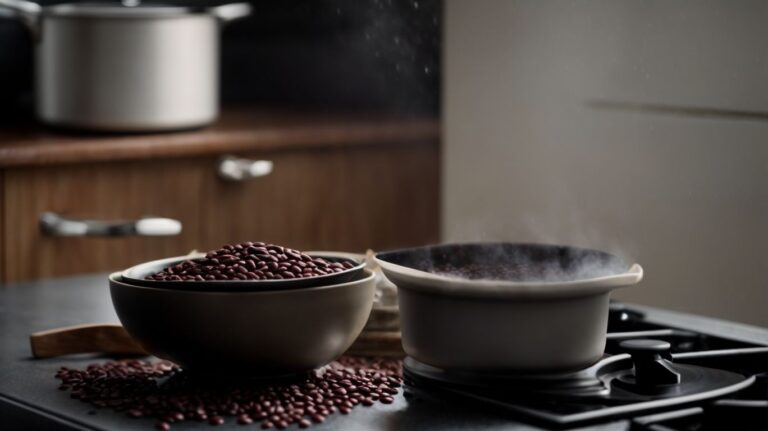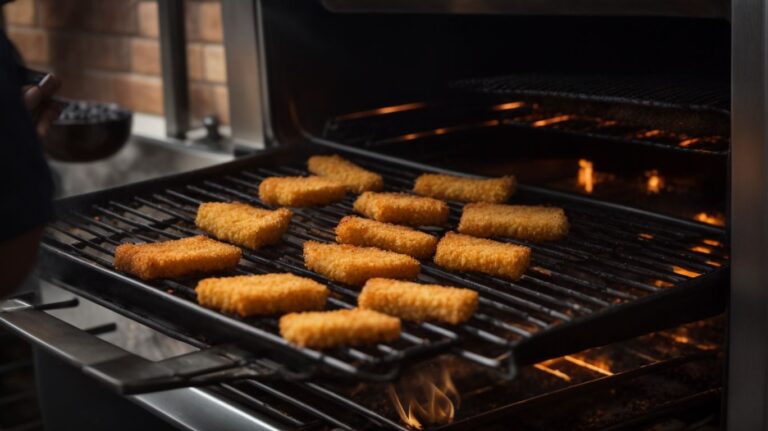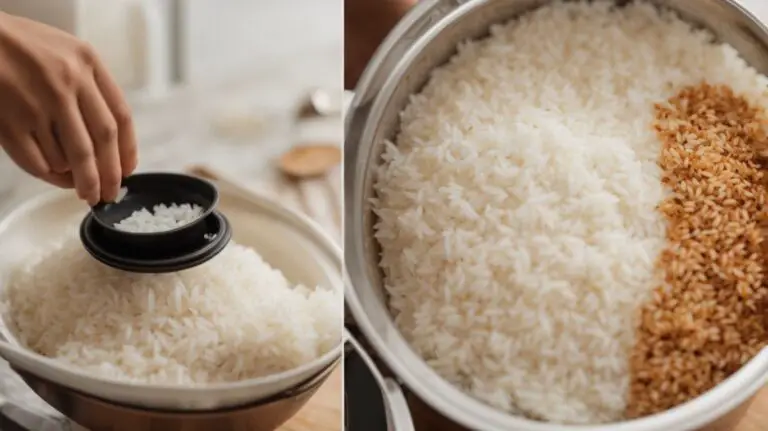How to Cook Wings for Buffalo Wings?
Are you a fan of spicy and flavorful Buffalo wings?
We will explore the key ingredients needed to make delicious Buffalo wings and provide a step-by-step guide on how to cook them to perfection.
From preparing the chicken wings to making the signature Buffalo sauce, we cover all the tips and tricks you need to elevate your wing game.
Get ready to impress your friends and family with the ultimate Buffalo wing recipe!
Key Takeaways:
What Are the Ingredients for Buffalo Wings?
Buffalo wings are a popular dish that requires specific ingredients to achieve the perfect blend of flavors and textures.
Let’s start with the main star of the dish, the chicken wings. These small, juicy portions are essential for creating the foundation of buffalo wings.
The buffalo sauce, made by combining hot sauce, butter, and a hint of garlic, provides the fiery kick that sets these wings apart. Butter adds richness and helps balance the heat of the sauce, while garlic introduces a savory depth of flavor. A pinch of salt and pepper elevate the taste, bringing out the natural flavors of the ingredients.
For those who like to dip their wings, ranch or blue cheese dressing is often served on the side. These creamy dressings offer a cool contrast to the spicy wings, providing a refreshing break between bites. Whether you prefer your wings mild, medium, or extra hot, each ingredient plays a crucial role in ensuring that every bite is packed with bold, mouth-watering flavors.
Chicken Wings
The key ingredient for buffalo wings is the chicken wings, which are typically separated into drumettes and flats, providing a combination of tender meat and crispy skin when prepared correctly.
When preparing buffalo wings, it is essential to choose high-quality chicken wings to ensure a delectable outcome. Opting for fresh, well-sized wings with a good meat-to-fat ratio can significantly impact the dish’s flavor and texture.
Drumettes, known for their meatier section, are perfect for those who prefer juicier bites, while flats offer a larger crispy skin surface, ideal for those craving a crunchier texture. Mixing both types can cater to different preferences among diners.
To achieve the desired crispy texture while keeping the meat juicy, a common practice involves a two-step cooking method. Coating the wings in a seasoned flour mixture before frying helps create a crispy outer layer, while retaining moisture inside.
Seasoning plays a crucial role in enhancing the flavor profile of buffalo wings. A classic mix of cayenne pepper, hot sauce, and other spices adds a kick to the dish. The flour coating, often seasoned with garlic powder, paprika, and salt, not only contributes to the crunch but also complements the savory taste of the chicken.
Hot Sauce
The hot sauce used in buffalo wings, often buffalo sauce or Frank’s Original Red Hot Sauce, provides the signature spicy kick and tangy flavor that defines this classic dish.
Buffalo wings have become a staple in American cuisine, and the choice of sauce greatly impacts the overall taste. Some variations include garlic buffalo sauce, honey buffalo sauce, or even a mango habanero sauce, each offering a unique twist to the original recipe. The key ingredient in these sauces is often cayenne pepper, which delivers the fiery heat that enthusiasts crave. With different levels of spice tolerance among consumers, buffalo wings offer a versatile option for customization. Whether you prefer mild, medium, or extra hot, there’s a buffalo wing sauce variation to suit every palate.
Butter
Butter is a crucial ingredient in buffalo wings, enhancing the richness of the sauce and balancing out the heat with its creamy texture.
In terms of buffalo wings, butter serves as the bridge between the fiery spice and the palate-soothing creaminess, creating a delightful amalgamation of flavors. The choice between salted and unsalted butter further delves into the realm of personal taste preferences.
While salted butter can add an extra savory kick to the sauce, unsalted butter provides a purer, more customizable base where the spiciness can truly shine. Ultimately, the decision rests on whether one seeks a nuanced flavor profile or a bold, salt-infused tang in their buffalo wings.
Garlic
Garlic, whether in the form of fresh cloves or powdered seasoning, adds depth and aromatic complexity to the buffalo wings, elevating the overall taste experience.
Fresh garlic cloves bring a pungent and robust flavor to the dish, infusing each bite with a distinct garlicky essence that complements the richness of the buffalo sauce. On the other hand, garlic powder offers a convenient way to incorporate garlic flavor evenly throughout the wings during the seasoning process.
Adjusting the amount of garlic used allows for customization according to personal preferences. Those who enjoy a more intense garlic presence can increase the amount, while others may prefer a milder hint of garlic to balance the overall taste.
Salt and Pepper
Salt and pepper are essential seasonings that help to balance the flavors in buffalo wings, enhancing the overall taste profile with their simple yet impactful seasoning.
When properly seasoned, salt adds a necessary kick of savory flavor, while pepper brings a subtle heat that complements the boldness of the buffalo sauce. The careful balance of these two seasonings is crucial to achieving that perfect umami taste that keeps you reaching for more wings.
To season buffalo wings effectively, a light dusting of salt and pepper before baking or frying is recommended, allowing the flavors to meld and work together with the chicken and sauce. For those who prefer a bolder flavor, a sprinkle of additional salt and a dash of extra pepper can be added after cooking to suit individual taste preferences.
Optional: Ranch or Blue Cheese Dressing
While optional, serving buffalo wings with a side of ranch or blue cheese dressing, alongside celery sticks, adds a creamy and cooling element to the dish, complementing the spicy flavors.
These classic dressings offer a rich and tangy profile that not only contrasts the heat of the wings but also provides a delightful balance. The cooler temperature of the dressing helps soothe the taste buds after a fiery bite, while the creaminess adds a luxurious texture. When presented with a platter of piping hot buffalo wings, the bowls of ranch or blue cheese are like cooling oases amidst the spice.
If you’re a fan of bold flavors, dipping the wings generously in the dressing can create a harmonious explosion of taste in your mouth. For those who prefer a lighter touch, drizzling the dressing over the wings like a sauce offers a more subtle yet still satisfying experience. Some even enjoy alternating between bites of wings and celery sticks dipped in the dressing for a refreshing crunch. The versatility of these dressings allows each diner to customize their buffalo wing experience to suit their preferences.
Step-by-Step Guide to Cooking Buffalo Wings
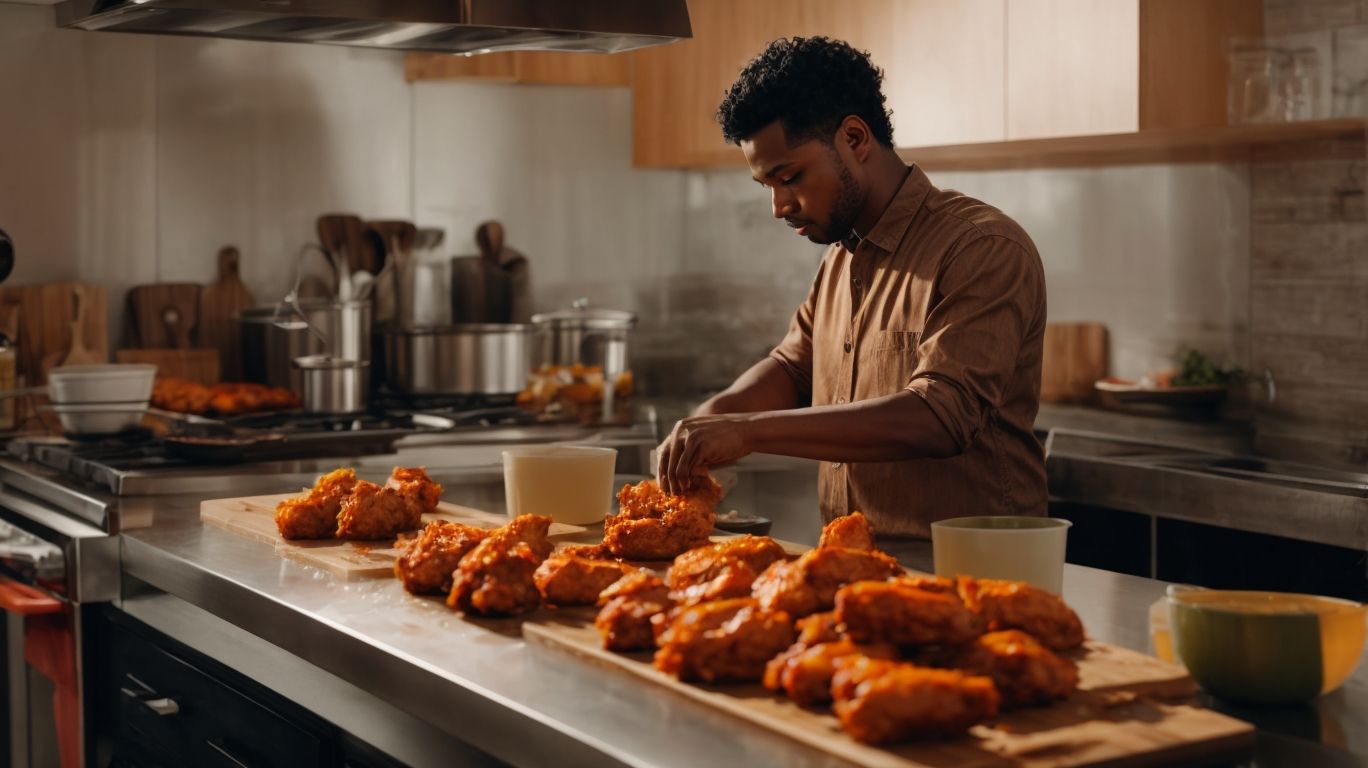
Credits: Poormet.Com – Carl Young
Cooking buffalo wings is a delightful process that involves a series of steps to achieve the perfect balance of crispy skin and tender meat, coated in a flavorful sauce.
If you want to ensure your buffalo wings come out just right, start by drying them thoroughly with a paper towel before seasoning. Next, place the wings in a large bowl and sprinkle them with a mixture of baking powder, salt, and pepper, ensuring they are evenly coated.
Then, select a baking sheet with a wire rack to elevate the wings, promoting air circulation for even cooking and maximum crispiness. Preheat your oven to 400°F before arranging the wings in a single layer on the rack.
Bake for approximately 45-50 minutes, flipping once halfway through. Once they are golden and crispy, toss the wings in your favorite buffalo sauce mixture. Serve them hot with classic accompaniments like celery sticks and blue cheese dressing for a truly satisfying meal.
Step 1: Prepare the Chicken Wings
The first step in cooking buffalo wings is preparing the chicken wings by ensuring they are seasoned, coated, and ready for baking to achieve the desired crispiness.
In terms of seasoning the chicken wings, you can go for a simple yet effective blend of salt, pepper, and garlic powder for a classic taste. Alternatively, experiment with marinades such as a mix of hot sauce, melted butter, and honey for a spicy-sweet kick. To ensure a crispy exterior, coat the wings in a mixture of flour and spices like paprika, cayenne pepper, and onion powder before placing them on a parchment-lined baking sheet.
For an extra flavorful twist, consider refrigerating the seasoned wings for a few hours or overnight to let the flavors penetrate the meat fully. This marinating process will elevate the taste profile and tenderize the chicken, creating a juicier end result. Once marinated, take the wings out of the fridge to let them come to room temperature before baking, allowing for more even cooking.
Step 2: Make the Buffalo Sauce
Creating the buffalo sauce is a crucial step in cooking buffalo wings, where a blend of ingredients comes together to form the signature spicy and tangy sauce that coats the wings.
To concoct this iconic sauce at home, you will need butter, hot sauce, vinegar, Worcestershire sauce, garlic powder, and a pinch of celery salt. The secret lies in the delicate balance of flavors; the heat from the hot sauce, the tangy kick from the vinegar, and the richness from the butter amalgamate beautifully to achieve that classic buffalo sauce taste.
The cooking method involves melting butter in a saucepan, adding the hot sauce, vinegar, Worcestershire sauce, garlic powder, and celery salt. Simmer the mixture for a few minutes until well combined, and voilà, your homemade buffalo sauce is ready to elevate your wings.
For those who prefer a milder version, reducing the hot sauce quantity while enhancing the richness with a bit more butter can do the trick. Conversely, if you crave an extra kick, consider incorporating some cayenne pepper or hot pepper sauce to amp up the heat factor.
Step 3: Preheat the Oven
To ensure the perfect cooking environment for buffalo wings, preheating the oven to the correct temperature is essential for achieving the desired level of crispiness and flavor.
When preheating your oven for buffalo wings, it’s crucial to set it to a high temperature, typically around 400-450°F. This initial blast of heat is what helps seal the juices inside the wings while crisping up the skin to perfection.
It’s important to note that ovens can vary in their accuracy, so invest in an oven thermometer to ensure your oven is truly at the correct temperature. Some ovens may run hotter or cooler, requiring you to adjust the temperature setting accordingly to achieve the best results.
Step 4: Bake the Wings
Baking the seasoned chicken wings in the preheated oven is a critical step in the buffalo wing cooking process, ensuring they become crispy, golden brown, and cooked to perfection.
Once you have assembled your seasoned wings on a baking sheet, it’s time to set the oven temperature to around 400°F. This temperature allows the wings to cook through evenly while developing that irresistible crispiness on the outside. The cooking time typically ranges between 45-50 minutes, but always keep an eye on them so they don’t overcook. To achieve consistent results, turn the wings halfway through the cooking process to ensure uniform browning. Remember, the key is to monitor the wings closely towards the end to achieve the desired level of crispiness without burning.
Step 5: Toss the Wings in the Buffalo Sauce
Coating the baked chicken wings in the prepared buffalo sauce is a crucial final step that infuses the wings with the signature flavors and ensures a deliciously coated exterior.
In terms of tossing the wings, one key technique is to use a large bowl to accommodate all the wings adequately. Ensuring each piece is evenly coated with the buffalo sauce requires a gentle yet thorough hand to toss them delicately.
For those who prefer a lighter coating, a spoon or silicone brush can be utilized to apply the sauce methodically, allowing for a more controlled distribution of the tangy flavor.
To achieve a perfect balance of flavors, consider mixing the buffalo sauce with a touch of honey or brown sugar to add a hint of sweetness that complements the spicy kick.
Step 6: Serve and Enjoy!
The final step in the buffalo wing cooking process is to serve the deliciously crispy wings alongside accompaniments like celery sticks and blue cheese dip, creating a perfect meal for any occasion.
In terms of presenting buffalo wings, consider arranging them on a platter topped with fresh celery sticks for that crunchy contrast and a creamy dollop of blue cheese dip to balance out the heat of the wings. Ensuring that the wings are arranged neatly not only enhances the visual appeal but also makes them easier to pick up and enjoy. Garnishing the platter with some fresh herbs or a sprinkle of paprika can add a touch of color and extra flavor.
Tips and Tricks for Perfect Buffalo Wings
Achieving the perfect buffalo wings requires attention to detail and some helpful tips and tricks to enhance the flavor, texture, and overall enjoyment of this iconic dish.
When preparing buffalo wings, always opt for fresh chicken wings as they yield the best results. To cater to varying taste preferences, adjust the spice level in the buffalo sauce by adding more or less hot sauce or cayenne pepper. A classic accompaniment to buffalo wings is serving them with celery and carrot sticks to balance the heat with freshness. For an extra level of crispiness, use a wire rack when baking the wings in the oven. To achieve the ultimate crunchiness, consider the technique of double-baking for a delightful texture that will have your guests coming back for more.
Use Fresh Chicken Wings
Using fresh chicken wings is essential for achieving the best texture and flavor in buffalo wings, ensuring a crispy exterior and juicy interior that elevate the overall dining experience.
In terms of selecting fresh chicken wings for your buffalo wings recipe, look for wings with smooth skin and a plump appearance. Fresh wings should have a pink hue and minimal odor, indicating their quality. Avoid wings that appear dry or discolored, as they may have been sitting for too long.
Quality wings should feel firm to the touch and not slimy or sticky.
Proper storage of chicken wings is also crucial to maintain their freshness. Store wings in the coldest part of your refrigerator, ideally below 40°F, and use them within 1-2 days of purchase for optimal results. Freshness plays a significant role in the overall satisfaction of your buffalo wings, as it impacts not only the taste but also the tenderness and succulence of the meat.
Adjust the Spice Level to Your Preference
Customizing the spice level of your buffalo wings allows you to tailor the dish to your personal preferences, whether you prefer a mild, medium, or extra hot flavor profile.
For those seeking a milder kick, consider reducing the amount of hot sauce in the recipe or opting for a milder hot sauce variant. Incorporating honey, brown sugar, or a touch of citrus can help balance out the heat, providing a sweet and tangy twist to the classic buffalo wing flavor.
If you’re aiming for a medium heat level, try mixing in some smoked paprika, garlic powder, or a splash of vinegar to enhance the depth of flavor without overwhelming the spiciness. These additions can add complexity while ensuring the heat remains manageable.
For the daring heat enthusiasts craving an extra hot experience, up the ante with cayenne pepper, ghost pepper sauce, or even a sprinkle of fiery chili flakes. To offset the intense heat, consider complementing it with cooling elements like blue cheese dip or celery sticks for a cooling contrast.
Serve with Celery and Carrot Sticks
Pairing buffalo wings with celery and carrot sticks not only adds freshness and crunch to the meal but also provides a cooling contrast to the spicy flavors, enhancing the overall dining experience.
The combination of buffalo wings and vegetable sticks offers a balanced and satisfying eating sensation. The light, crisp texture of the celery and carrots perfectly complements the rich and bold taste of the wings, creating a harmonious blend of flavors and mouthfeel. Munching on the refreshing vegetables in between bites of the fiery wings can help cleanse the palate, preparing it for the next burst of heat.
To elevate this experience further, consider pairing the vegetable sticks with creamy ranch or tangy blue cheese dips. These flavorful sauces not only provide a delicious accompaniment but also introduce a variety of taste profiles, making each bite a delightful adventure.
Use a Wire Rack for Crispy Wings
Utilizing a wire rack during the baking process is a smart technique for ensuring that buffalo wings come out crispy and evenly cooked, with optimal airflow for achieving that perfect golden-brown exterior.
Wire racks are designed to elevate food, allowing heat to circulate evenly around it. This feature helps prevent the buffalo wings from becoming soggy by allowing excess grease to drip away, leading to a crisper texture. When selecting a wire rack for baking, opt for one with a tight grid pattern to support the wings without them falling through. Position the rack on a baking sheet lined with foil or parchment paper to catch any drippings, and make sure to space the wings evenly for consistent cooking.
Double-Bake for Extra Crispy Wings
The technique of double-baking buffalo wings involves a second round of baking to achieve an extra crispy exterior, intensifying the flavors and textures for a truly indulgent wing-eating experience.
In terms of executing this method, it’s essential to start with properly cooked wings from the initial bake. To begin the second round, preheat your oven to around 400-425°F (200-220°C). Once heated, place the wings back in, allowing them to crisp up further. This additional bake not only enhances the crunchiness but also aids in ensuring that the seasonings and sauces adhere perfectly to the wings, creating a mouthwatering blend of flavors. The extended baking time allows for a thorough infusion of flavors, resulting in wings that are both incredibly crispy and packed with delicious tastes.
Frequently Asked Questions
What is the best way to cook wings for buffalo wings?
The best way to cook wings for buffalo wings is by frying them. This will ensure a crispy exterior and juicy interior, just like the restaurant-style buffalo wings we all love.
Can I bake wings for buffalo wings instead of frying them?
Yes, you can bake wings for buffalo wings. However, they will not have the same crispy texture as fried wings. If you choose to bake them, make sure to coat them in a mixture of cornstarch and baking powder to help them crisp up.
How long should I cook wings for buffalo wings?
The cooking time for wings can vary depending on the size and type of wings. On average, it takes about 12-15 minutes to fry or bake wings for buffalo wings. It’s important to use a meat thermometer to ensure they are cooked to an internal temperature of 165°F.
What is the best oil to use for frying wings?
The best oil to use for frying wings is one with a high smoke point, such as canola, peanut, or vegetable oil. These oils can withstand high heat without burning or smoking, resulting in perfectly cooked wings.
Can I use frozen wings for buffalo wings?
Yes, you can use frozen wings for buffalo wings. However, make sure to fully thaw them before cooking to ensure even cooking. You can also cook them for a few extra minutes to ensure they are fully cooked.
How can I make healthier buffalo wings?
If you want to make healthier buffalo wings, try baking them instead of frying them. You can also use boneless, skinless chicken breast instead of wings, and coat them in a mixture of almond flour and spices instead of traditional breading. Another option is to use an air fryer to cook the wings with little to no oil.

